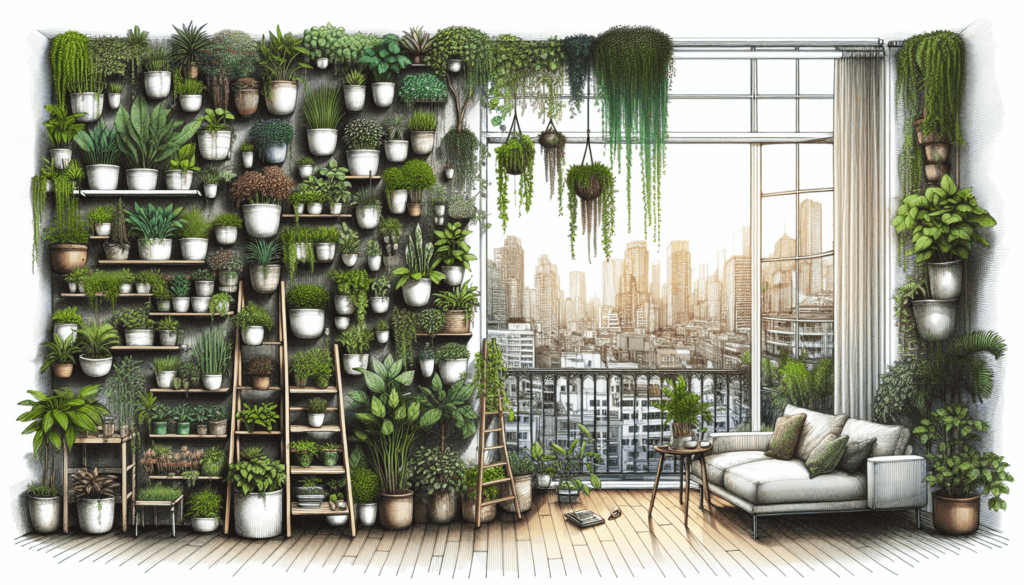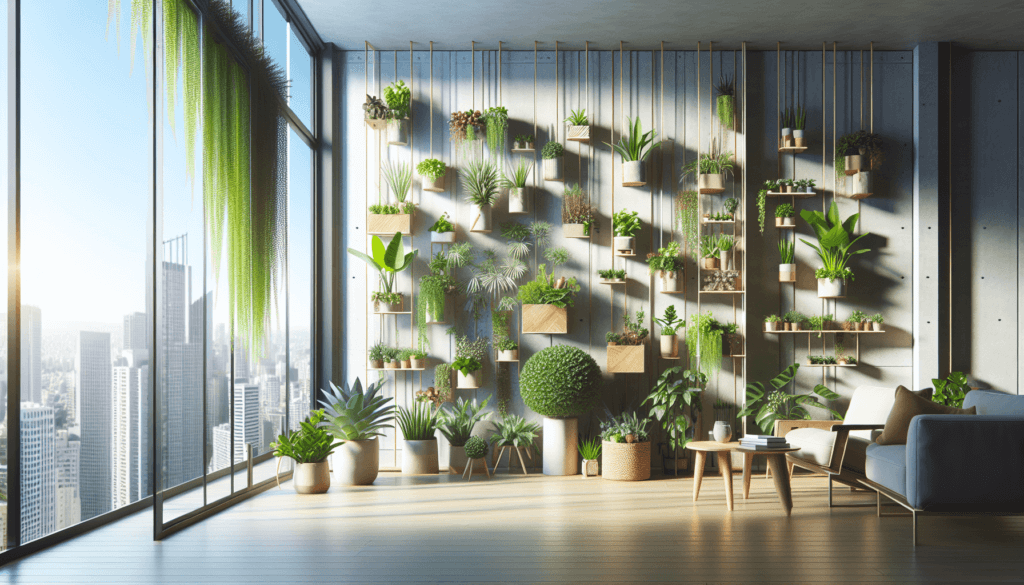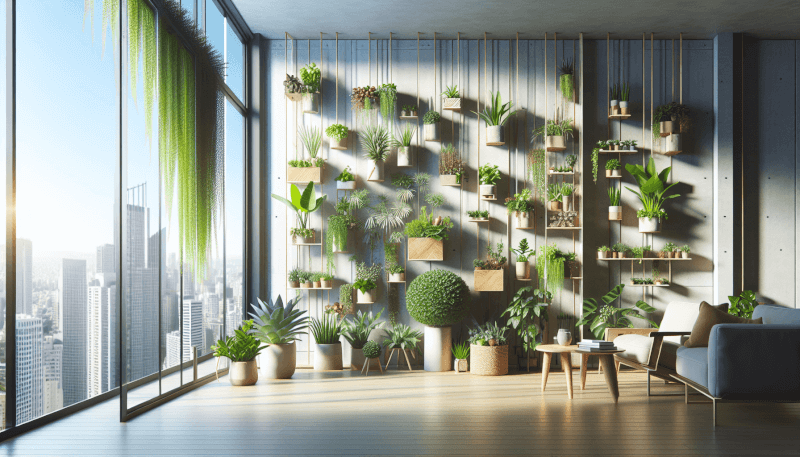Living in a city apartment doesn’t mean you have to miss out on the joy of gardening. With limited space, a small vertical garden is the perfect solution to bring greenery and life into your urban dwelling. In this article, we will show you step-by-step how to create your own small vertical garden, providing you with a peaceful oasis amidst the bustling cityscape. From selecting the right plants to maximizing vertical space, you’ll soon discover that creating a beautiful garden in your apartment is both achievable and rewarding.

Choosing the Right Plants for a Vertical Garden
Consider the available space and lighting conditions
When choosing plants for a vertical garden, it’s important to consider the available space and lighting conditions in your apartment. Assess the amount of sunlight that reaches the wall where you plan to install the vertical garden. Some plants require full sun, while others can thrive in partial or even low light conditions. Make sure to choose plants that are suitable for the amount of sunlight available in your space.
Select plants that thrive in indoor environments
Since a vertical garden in a city apartment is typically located indoors, it’s essential to choose plants that thrive in these conditions. Look for plants that are known to adapt well to indoor environments and can tolerate lower light levels. Some popular options for indoor vertical gardens include pothos, spider plant, philodendron, and heartleaf philodendron. These plants are not only visually appealing but also relatively low-maintenance.
Choose plants that have shallow roots
When it comes to vertical gardens, it’s important to choose plants with shallow roots. Since the plants will be growing in containers or pockets on a wall, they won’t have access to the same depth of soil as plants in a traditional garden. Opting for plants with shallow roots ensures they have enough space to grow, thrive, and absorb nutrients within the limited soil depth provided by the vertical garden system.
Opt for plants that are easy to maintain
Maintaining a vertical garden should be a joy, not a chore. Therefore, it’s advisable to choose plants that are easy to care for and require minimal attention. Look for plants that don’t require frequent watering, pruning, or excessive fertilization. This way, you can enjoy the beauty of your vertical garden without spending too much time and effort on its upkeep.
Designing and Planning Your Vertical Garden
Assess the available wall space
Before diving into the design and planning process, take the time to assess the available wall space in your city apartment. Measure the dimensions of the wall where you intend to install the vertical garden. Consider any obstructions like windows or power outlets that might affect the layout of the garden. By understanding the limitations and possibilities of your wall space, you can determine how many plants you can accommodate and plan your design accordingly.
Decide on the type of vertical garden system
There are various types of vertical garden systems available, each with its own pros and cons. Some popular options include pocket systems, modular panel systems, and trellis systems. Pocket systems feature individual pockets or containers that hold the plants. Modular panel systems consist of interlocking panels that can be customized to fit your space. Trellis systems provide support for climbing plants. Consider the specific needs of the plants you have chosen and the aesthetic appeal of different systems when deciding on the most suitable option for your vertical garden.
Create a layout for your garden
Once you have chosen a vertical garden system, it’s time to create a layout for your garden. Consider the size and shape of the plant pockets or containers when determining the placement of each plant. Think about the arrangement of colors, textures, and sizes to create an aesthetically pleasing design. Additionally, consider the growth habits of the plants and how they will interact with one another as they mature. A well-thought-out layout will contribute to the overall visual impact of your vertical garden.
Determine the number of plant pockets required
Based on the available wall space and the layout you have created, determine the number of plant pockets or containers required for your vertical garden. Take into account the desired density of plants and the allocated space for each plant. Remember to leave enough room for the plants to grow and spread their foliage. If possible, purchase extra pockets or containers to allow flexibility in changing or expanding your vertical garden in the future.
Preparing the Wall and Installing the Vertical Garden System
Clean the wall surface
Before installing the vertical garden system, it’s crucial to clean the wall surface thoroughly. Remove any dust, dirt, or debris from the wall using a soft brush, sponge, or cloth. This will ensure proper adhesion of the vertical garden system and prevent any unwanted particles from interfering with the plants’ growth. Pay close attention to corners and crevices to ensure a clean and smooth surface.
Seal the wall if necessary
If the wall surface is porous or prone to water damage, consider sealing it before installing the vertical garden system. Sealing the wall will help protect it from moisture damage and ensure the longevity of your vertical garden. Consult with a professional or follow the manufacturer’s instructions when choosing and applying an appropriate sealant for your specific wall type.
Install the vertical garden system according to the manufacturer’s instructions
Each vertical garden system comes with its own installation instructions. It’s important to carefully read and follow these instructions to ensure proper installation. Start by attaching any required brackets or supports to the wall, following the recommended spacing guidelines. Then, attach the pocket modules or containers to the brackets or supports, making sure they are securely in place. Take your time during the installation process to ensure stability and prevent any potential issues in the future.
Ensure proper support and stability
Once the vertical garden system is installed, ensure it has proper support and stability. Check that all brackets, supports, and pocket modules are securely attached to the wall. Gently tug on the system to test its stability, making any necessary adjustments or reinforcements if needed. Ensuring proper support and stability will prevent the system from becoming loose or falling, protecting both your plants and your apartment walls.
Preparing the Plants for Vertical Gardening
Remove plants from their pots and loosen the roots
Before planting the plants in the vertical garden system, gently remove them from their pots and loosen the roots. Gently tap the bottom of the pot to release the root ball, being careful not to damage the plant or disturb the root system. Loosening the roots will help the plants adapt more easily to their new environment and encourage healthy growth.
Trim any excessively long roots or foliage
If any of the plants have excessively long roots or foliage, trim them to promote balanced growth in the vertical garden. Use clean and sharp gardening shears or scissors to carefully remove any extra length. Trimming long roots and foliage will reduce the risk of entanglement and help the plants establish themselves more effectively in the vertical garden system.
Soak the plants in water to ensure hydration
To ensure proper hydration before planting, soak the plants in water for a short period of time. Fill a container or basin with water and place the plants, allowing the root system to soak up moisture. This step is particularly important for plants that have been recently transplanted or those that have been stored in dry conditions. Proper hydration will support the plants’ ability to establish and thrive in the vertical garden.
Consider using a rooting hormone to promote growth
Using a rooting hormone can be beneficial, especially when planting new cuttings or establishing plants in the vertical garden. Rooting hormones contain natural or synthetic substances that encourage root development and improve plant growth. Dip the cut ends of the plants in a rooting hormone powder or solution before planting them in the vertical garden system. This will provide an extra boost for the plants as they adjust to their new environment.

Planting and Positioning the Plants in the Vertical Garden
Insert the plants into the pockets or containers of the vertical garden system
Once the plants are prepared, it’s time to insert them into the pockets or containers of the vertical garden system. Carefully place each plant into its designated slot, ensuring the roots are properly tucked in and covered with soil or growing medium. Be gentle when handling the plants to avoid damaging delicate foliage or stems. Take your time and plant each one with care to give them the best chance of thriving in the vertical garden.
Position taller plants towards the back and shorter ones towards the front
When arranging the plants in the vertical garden, consider their height and growth habits. Position taller plants towards the back of the garden, where they won’t obstruct the view of smaller plants. This will create a visually pleasing display and ensure that each plant receives adequate light. Place shorter plants towards the front or lower sections of the vertical garden, allowing their beauty to be easily appreciated.
Ensure proper spacing between plants for adequate growth
To ensure adequate growth and prevent overcrowding, provide proper spacing between the plants in your vertical garden. The recommended spacing will vary depending on the specific plants you have chosen. Research the mature size and growth requirements of each plant to determine the appropriate distance between them. Providing enough space will allow the plants to grow and flourish without competing for resources or inhibiting each other’s growth.
Secure the plants in place to prevent tipping
Once the plants are positioned in the vertical garden, it’s important to secure them in place to prevent tipping or dislodging. Gently press the soil or growing medium around the base of each plant to provide stability. If necessary, use garden stakes or ties to keep the plants upright and secure. Taking these precautions will ensure the plants stay in place as they grow and develop in your vertical garden.
Watering and Fertilizing Your Vertical Garden
Water the plants regularly to maintain adequate moisture levels
Proper watering is crucial for the health and vitality of your vertical garden. Regularly check the moisture levels of the soil or growing medium and water the plants accordingly. While the frequency of watering will depend on the specific plants and environmental conditions, it’s generally recommended to provide enough water to keep the soil consistently moist but not waterlogged. Invest in a watering can or small hose attachment to make the watering process easier and more efficient.
Consider using an automated irrigation system for convenience
If you prefer a more hands-off approach to watering, consider installing an automated irrigation system for your vertical garden. These systems can be set to release water at specific intervals, ensuring your plants receive adequate hydration even when you’re not available to water them manually. Automated irrigation systems can be particularly beneficial if you travel frequently or have a busy lifestyle that doesn’t allow for regular watering.
Apply a suitable liquid fertilizer according to the plant’s requirements
In addition to watering, providing proper nutrients is essential for the overall health and growth of your vertical garden. Choose a suitable liquid fertilizer based on the specific requirements of the plants you have chosen. Follow the instructions provided by the manufacturer for the appropriate dilution and application rates. Regularly fertilizing your plants will supply them with the necessary nutrients for vibrant foliage, beautiful blooms, and bountiful harvests.
Monitor the soil moisture and adjust watering frequency accordingly
As your vertical garden matures, it’s important to monitor the soil moisture levels and adjust the watering frequency accordingly. Inspect the soil or growing medium regularly by inserting your finger into it, about one inch deep. If the soil feels dry at that depth, it’s time to water. If it’s still moist, hold off on watering until the soil has dried out slightly. By closely monitoring the soil moisture, you can prevent overwatering or underwatering, allowing your plants to thrive.

Maintaining and Pruning Your Vertical Garden
Monitor the plants for signs of pests or diseases
Regularly monitor your vertical garden for signs of pests or diseases. Inspect the plants’ leaves, stems, and flowers for any unusual spots, discoloration, or wilted areas. Look for signs of insect activity, such as webbing or holes in the foliage. If you notice any issues, take prompt action to address and treat the problem. Research natural or organic methods for pest and disease control to minimize the use of chemical treatments.
Remove any dead or yellowing leaves to promote healthy growth
To promote healthy growth and maintain the overall appearance of your vertical garden, remove any dead or yellowing leaves. These leaves not only detract from the visual appeal of your garden but can also harbor pests or diseases. Use clean and sharp gardening shears or scissors to carefully trim away any unsightly or damaged foliage. Regularly removing dead leaves will keep your plants looking fresh and vibrant.
Prune the plants to maintain their desired shape and size
Pruning is an essential part of vertical garden maintenance. As the plants grow, they may require periodic pruning to maintain their desired shape and size. Trim back any overgrown or straggly branches to promote a bushier, more compact appearance. Focus on removing any dead, damaged, or weak growth to redirect the plant’s energy towards healthy new growth. Regular pruning will keep your vertical garden looking tidy and ensure optimal plant health.
Regularly clean the vertical garden system to prevent clogging
To ensure the proper functioning of your vertical garden system, regularly clean it to prevent clogging. Remove any debris, fallen leaves, or plant residue that may accumulate in the pockets or containers. Use a soft brush or cloth to gently brush away any dirt or dust from the surface of the system. Cleaning your vertical garden system will help maintain good airflow, prevent disease transmission, and ensure optimal plant performance.
Providing Adequate Lighting for Your Vertical Garden
Ensure the vertical garden receives sufficient natural light
Proper lighting is essential for the success of your vertical garden. Ensure that the wall where your garden is located receives sufficient natural light. Observe the amount of sunlight the wall receives throughout the day and note any areas of shade or direct sunlight. If your vertical garden is not receiving enough natural light, consider moving it to a different location in your apartment or supplementing with artificial lighting.
Supplement natural light with artificial lighting if necessary
If your vertical garden is located in an area with limited natural light, consider supplementing it with artificial lighting. LED grow lights are an excellent choice for indoor gardening, as they provide the necessary spectrum of light for plant growth. Position the lights at an appropriate distance from the plants, considering their light requirements and the recommended intensity levels. Set timers to ensure consistent and adequate lighting for your vertical garden.
Position the plants according to their light requirements
When arranging the plants within your vertical garden, take into account their individual light requirements. Position plants that prefer more sunlight closer to the light source, or in areas that receive the most direct sunlight. For shade-tolerant plants, place them in areas of partial or filtered light. By considering the specific light needs of each plant, you can create an environment that promotes optimal growth and overall plant health.
Use reflective surfaces to maximize light exposure
To maximize light exposure for your vertical garden, consider incorporating reflective surfaces into your space. Mirrors, light-colored walls, or metallic accents can help bounce light off nearby surfaces and create a more light-filled environment for your plants. Strategically placing reflective surfaces can increase the overall brightness and intensity of the available light, enhancing the growth and vitality of your vertical garden.

Creating a Support Structure for Climbing Plants
Install a trellis or wire mesh for climbing plants to hold onto
If you’ve chosen to include climbing plants in your vertical garden, it’s important to provide a suitable support structure for them to hold onto. Install a trellis or wire mesh along the wall or within the vertical garden system to allow the climbing plants to grow vertically. Ensure that the support structure is securely attached to the wall and can withstand the weight and growth of the plants.
Guide the plants towards the support structure as they grow
As the climbing plants in your vertical garden grow, guide them towards the support structure to ensure they attach and climb properly. Gently train the stems or tendrils of the plants along the trellis or wire mesh, helping them find their way to the vertical support. Be patient and observant, as some plants may need assistance in attaching themselves to the structure. With time and guidance, your climbing plants will thrive and create a beautiful vertical display.
Regularly check and adjust the support structure as needed
Regularly check the condition of the support structure for your climbing plants and make any necessary adjustments. Over time, as the plants grow and develop, the support structure may require reinforcement or realignment. Check for any loose or damaged sections and repair them promptly. By regularly maintaining the support structure, you can ensure the safety and stability of your climbing plants.
Train the climbing plants to adhere to the support structure
To encourage the climbing plants to adhere to the support structure, gently train their growth. As the plants produce new stems or tendrils, guide them towards the support system and intertwine them as needed. Avoid forcefully bending or twisting the plants, as this can cause damage. Gradually train the plants to adhere to the support structure, taking care not to disrupt their natural growth patterns. With time and patience, the climbing plants will embrace the structure and create a stunning vertical display.
Harvesting and Enjoying the Fruits of Your Vertical Garden
Harvest the fruits and vegetables when they are ripe
As your vertical garden matures, you’ll have the joy of harvesting the fruits of your labor. Monitor the progress of your fruits and vegetables closely and harvest them when they are ripe. Each plant will have specific indications of ripeness, such as changes in color, size, or texture. Carefully harvest the produce using clean and sharp gardening tools to avoid damaging the plants or introducing pathogens. Harvesting at the right time will maximize flavor and freshness.
Continuously monitor the plants for maturity and readiness to harvest
Even after your first round of harvesting, it’s important to continuously monitor the plants for maturity and readiness to harvest. Some crops, such as leafy greens or herbs, can be harvested multiple times throughout their growing cycle. Regularly inspect the plants for new growth or signs of readiness, ensuring that no produce goes to waste. By staying attentive and proactive, you can enjoy a continuous supply of fresh and delicious produce from your vertical garden.
Share the garden’s produce with friends, family, or neighbors
One of the joys of gardening is being able to share the fruits of your labor with others. If you find yourself with an abundance of produce from your vertical garden, consider sharing it with friends, family, or neighbors. A basket of freshly harvested vegetables or a bouquet of homegrown herbs can make a thoughtful and appreciated gift. Sharing your garden’s bounty not only spreads the joy of gardening but also fosters a sense of community and connection.
Experience the joy and satisfaction of growing your own food
Lastly, take a moment to experience the joy and satisfaction of growing your own food in a city apartment. Cultivating a small vertical garden allows you to connect with nature, even in the midst of an urban environment. Witnessing the growth, care, and eventual harvest of your plants nurtures a sense of accomplishment and fulfillment. Embrace the experience and savor the flavors of your homegrown produce, knowing that you have created something beautiful and nourishing.



